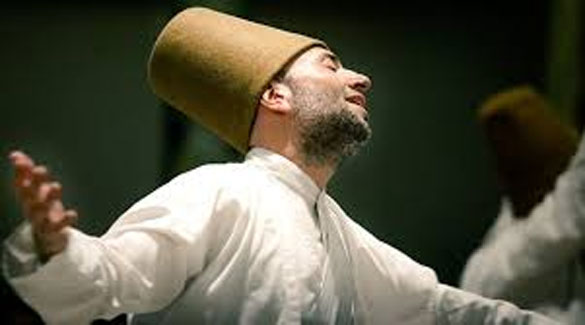
By S. Arshad, New Age Islam
24 July 2020
Sufism as a separate and distinct spiritual doctrine took shape in the last years of the second century Hijri when the disciple of Hadhrat Ali (RA) Abu Hashim Kufi was identified as the first Sufi.
 Sketch by Author
Sketch by Author
----
However, the practices of Sufis were largely based on the Quranic injunctions related to remembrance of Allah. There are a number of verses that ask the Muslims to remember Allah all through the waking hours.
"Sing his praise morning and evening."(Al Fath:9)
"And utter his name morning and evening."(Ad Dahr:25)
"And remember Allah in your heart in humility and fear and in a voice that is low morning and evening and do not remain forgetful (of his remembrance).” (Al Araf:205)
" O believers, remember Allah profusely and sing His praise morning and evening."(Al Ahzab:42)
These verses urged Muslims to spend more and more time in remembrance of God and gradually a section of Muslims formed a group that spent more time in remembering and uttering the name of God and in course of time were known as Sufis.
 Photo: Courtesy/Eurasia Review
Photo: Courtesy/Eurasia Review
-----
In fact, there are some verses that even seem to defend those Sufis and advise Muslims to join their company.
"And hold back yourselves with those who call out their God morning and evening and seek God's attention and let not your eyes wander in search of the luxuries of the life of this world leaving them."(Al Kahf:28)
"And whoever avoids remembrance of God, We appoint upon him a Satan who will be his companion."(Az Zukhruf:46)
Thus, early Sufis found justification for their mystic practices in the holy Quran. However, social and political conditions of Arab during the Umayyid and later Abbasid rule
were a major factor for the promoting of Sufism as a way of life among the general Muslims. These were the circumstances that had compelled Hadhrat Hasan (A.S) to withdraw from public life and spend more time in solitude. Later the martyrdom of Hadhrat Imam Hussain (R.A) and most of the Ahl-e-Bayt in Karbala pushed the general Muslims into a state of disappointment and despair. The environment of conspiracies, mischief and anarchy compelled Muslims to seek solace in prayers and remembrance of God. People also took resort to Sufism because many religious and ideological differences were coming up among Muslims and the general Muslims did not find a clue what to do in the circumstances.
In fact, it was not in the Arab Muslim world alone that political and social disintegration and anarchy promoted spiritual movements. In India too, when the rulers and the upper caste people oppressed the lower caste people, they formed their own spiritual groups and folk religions.
In later centuries Islamic Sufism acquired doctrinal foundations after the mystics of different religions found a common ground among their spiritual practices. They realised that they were the travellers of the same path and seekers of the same goal, the pleasure of the Supreme Being.
.jpg) Facebook/ Christian Sufism
Facebook/ Christian Sufism
----
Meetings between the followers of different religions and exchange of ideas and beliefs among the Christian, Buddhist and Hindu ascetics and scholars influenced their beliefs and thought process.
It is said that during Abbasid Caliphate, debates and discussions on religious issues were commonplace. In these discussions, Hindu and Buddhist scholars also took part along with Muslims. Through these meetings and discussions, Muslims became aware of Vedic and Buddhist beliefs and practices. During the 9th century, some prominent Sufis were born who were influenced by Christian and Vedic religious philosophy. For example, Hadhrat Junaid Baghdadi (b. 830 AD) who was a great Muslim Sufi was born and brought up in a Christian religious environment as his parents were initially Christians and had later converted to Islam. During this period Egypt, Suria and Iraq were centres of Christian Monasticism.
.jpg) Sanctuary for Ali’s Footprints, attributed to Aqa Mirak, from A Book of Divination, 1550-1560. © Musées d’art et d’histoire de Genéve, Cabinet d’arts graphiques
Sanctuary for Ali’s Footprints, attributed to Aqa Mirak, from A Book of Divination, 1550-1560. © Musées d’art et d’histoire de Genéve, Cabinet d’arts graphiques
-----
Hadhrat Bayazid Bustami (b. 804 AD) was influenced by Buddhist ideas and practices. He learnt about Ilm-e-Fana (merger into the Supreme Being) from his disciple Abu Ali Sindhi. During that period, Sindh was a centre of Buddhism and Hinduism. The concept of the dissolution of Self (Fana-e-Zat) into the Supreme Being is a Buddhist and Vedic concept.
Hussain bin Mansur Hallaj (b. 858 AD) who was killed for his assertion that he was the Truth (An-al Haque) was greatly influenced by the Vedic philosophy. Shaikh Fariduddi. Attar has written about Hallaj's travel to India and China. Hussain Hallaj had borrowed the idea of "I am the Truth" from the Vedanta in which the final destination of Man is the realization that
"Aham Brahmasmi" (I am Brahma) (Brigadaranyak Upanishad 1.4.10)
Pragyanam Brahman (Knowledge is Brahman) (Aitareya Upanishad 3.3)
Ayam Atman Brahman (This soul is Brahman) (Mandukya Upanishad 1.2)
 Sufism does come close to ascetic Hinduism, because their similarity is not religion itself, but the idea of detachment
Sufism does come close to ascetic Hinduism, because their similarity is not religion itself, but the idea of detachment
-----
Katha Upanishad says that The Supreme Being is hidden in all the beings but He cannot be realised because the vision is covered by ignorance and the Supreme Being does not appear in the form of, I am Brahman. Therefore, the mystics and Sufis after removing the curtain say, I am Brahman (Anal Haque).
In the 12th century, a Sanskrit book Amrit Kund influenced the thought of the poet, philosopher and Sufi Ibn-e Arabi. He went through its Arabic translation "Hauzul Hayat.” The book dealt with the philosophy of Advaitavad (Monism). Ibn-e-Arabi propounded the philosophy of Wahdatul Wujud based on his understanding of the book. He founded his ideas on Wahdatul Wujud on the verses of the Quran, therefore making the philosophy acceptable, rather irrefutable by Islamic scholars. His arguments and logic in favour of the philosophy of Wahdatul Wujud were so powerful that even the staunchest opponents of Sufism like Mohammad Iqbal had to say that though he was against Sufism but he could not issue any Fatwa against Ibn-e-Arabi because he had explained his philosophy with the verses of the Quran.
The philosophy of Wahdatul Wujud became very popular among Sufis worldwide which was based on Advaitavad of the Vedanta.
Later in the 16th century Indian Sufi of Shattari order Shah Mohammad Ghaus Gawalari translated the same book Hauzul Hayat into Persian named Bahr-e-Hayat. This book contains meditative techniques and Yogasanas with illustrations. Thus, Mohammad Ghaus Gawaliari introduced Yogic practices in Sufism. During its translation Mohammad Ghaus met Nath Yogis and learnt about their beliefs and philosophy.
This is the reason many Islamic scholars consider Sufism an un-Islamic concept but at the same time, an equally large number of Islamic scholars believe that Islamic Sufism is different from Hindu and Buddhist Advaitavad or Christian Monasticism. Islamic Sufism has borrowed only those elements from other religions that enrich it and make it more universal without interfering with or disturbing the fundamental principles of Islam.

No comments:
Post a Comment